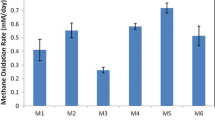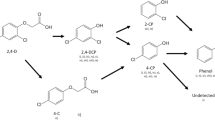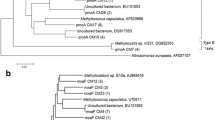Summary
Soil was taken from the top 10 cm of a soil column that removed halogenated aliphatic hydrocarbons in the presence of natural gas. This soil was used as an enrichment inoculum to determine that the removals seen in the soil column were in fact of a microbiological nature. Methane served as the source of carbon and energy and was consumed immediately by the enrichments. After several transfers of the enrichments, a stable consortium of at least three bacterial types was obtained. The predominant bacterium was a non-motile, gram-negative coccus. This stable consortium was able to remove chlorinated methanes, ethanes, and ethylenes when grown with methane and oxygen in the headspace. Methane was required for the removals to be observed. Acetylene inhibited the removals, which further suggests the involvement of methanotrophs. Benzene and toluene were removed by the mixed culture with or without methane in the headspace. Fatty acid analysis of the mixed culture resulted in a profile that indicated that the predominant organism was a type II methanotroph. This study provides further evidence that methanotrophic bacteria are capable of cometabolizing a wide range of chlorinated methanes, ethanes, and ethylenes.
Similar content being viewed by others
References
Bouwer, E.J. and P.L. McCarty. 1982. Removal of trace chlorinated organic compounds by activated carbon and fixed film bacteria. Environ. Sci. Technol. 16: 836–843.
Bouwer, E.J., B.E. Rittman and P.L. McCarty. 1981. Anaerobic degradation of halogenated 1- and 2-carbon organic compounds. Environ. Sci. Technol. 15: 596–599.
Brunner, W., D. Staub and T. Leisinger. 1980. Bacterial degradation of dichloromethane. Appl. Environ. Microbiol. 40: 950–958.
Colby, J., H. Dalton and R. Whittenbury. 1975. An improved assay for methane mono-oxygenase. Biochem. J. 151: 459–462.
Colby, J., D.I. Stirling and H. Dalton. 1977. The soluble methane mono-oxygenase ofMethylococcus capsulatus (Bath). Its ability to oxygenate n-alkanes, n-alkenes, ethers, and alicyclic, aromatic and heterocyclic compounds. Biochem. J. 165: 395–402.
Fogel, M.M., A.R. Taddeo and S. Fogel. 1986. Biodegradation of chlorinated ethenes by a methane-utilizing mixed culture. Appl. Environ. Microbiol. 51: 720–724.
Henson, J.M., M.V. Yates, J.W. Cochran and D.L. Shackleford. 1988. Microbial removal of halogenated methanes, ethanes, and ethylenes in an aerobic soil exposed to methane. FEMS Microbiol. Ecol. 53: 193–201.
Janssen, D.B., G. Grobben and B. Witholt. 1987. Toxicity of chlorinated aliphatic hydrocarbons and degradation by methanotrophic consortia. p. 515–518. In: Proceedings of the 4th European Congress on Biotechnology 1987 (Neijssel, O.M., R.R. van der Meer and K.Ch.A.M. Luyben, eds.) pp. 515–518, Elsevier Science Publishers, Amsterdam.
Janssen, D.B., A. Schepfer, L. Dijkhuizen and B. Witholt. 1985. Degradation of halogenated aliphatic compounds byXanthobacter autotrophicus GJ10. Appl. Environ. Microbiol. 49: 673–677.
Nelson, M.J.K., S.O. Montgomery, W.R. Mahaffey and P.H. Pritchard. 1987. Biodegradation of trichloroethylene and involvement of an aromatic biodegradation pathway. Appl. Environ. Microbiol. 53: 949–954.
Nelson, M.J.K., S.O. Montgomery, E.J. O'Neill and P.H. Pritchard. 1986. Aerobic metabolism of trichloroethylene by a bacterial isolate. Appl. Environ. Microbiol. 52: 383–384.
Nichols, P.D., J.B. Guckert and D.C. White. 1986. Determination of monounsaturated fatty acid double bond position and geometry for microbial monocultures and complex consortia by capillary gas chromatography-mass spectroscopy of their dimethyl-disulphide adducts. J. Microbiol. Methods 5: 49–55.
Nichols, P.D., J.M. Henson, C.P. Antworth, J. Parsons, J.T. Wilson and D.C. White. 1987. Detection of a microbial consortium, including type II methanotrophs, by use of phospholipid fatty acids in an aerobic halogenated hydrocarbondegrading soil column enriched with natural gas. Environ. Toxicol. Chem. 6: 89–97.
Nichols, P.D., G.A. Smith, C.P. Antworth, R.S. Hanson and D.C. White. 1985. Phospholipid and lipopolysaccharide normal and hydroxy fatty acids as potential signatures for methane-utilizing bacteria. FEMS Microbiol. Ecol. 31: 327–355.
Pankow, J.F. and M.E. Rosen. 1984. The analysis of volatile compounds by purge and trap with whole column cryotrapping (WCC) on a fused silica capillary column. J. High Resolut. Chromatogr. Chromatogr. Commun. 7: 504–516.
Patt, T.E., G.C. Cole, J. Bland and R.S. Hanson. 1974. Isolation and characterization of bacteria that grow on methane and organic compounds as sole sources of carbon and energy. J. Bacteriol. 120: 955–964.
Strand, S.E. and L. Shippert. 1986. Oxidation of chloroform in an aerobic soil exposed to natural gas. Appl. Environ. Microbiol. 52: 203–205.
Vogel, T.M., C.S. Criddle and P.L. McCarty. 1987. Transformations of halogenated aliphatic compounds. Environ. Sci. Technol. 21: 722–736.
Westrick, J.J., J.W. Mello and R.F. Thomas. 1984. The groundwater supply survey. J. Am. Water Works Assoc. 76: 52–59.
Wilson, J.T., C.G. Enfield, W.J. Dunlap, R.L. Cosby, D.A. Foster and L.B. Baskin. 1981. Transport and fate of selected organic pollutants in a sandy soil. J. Environ. Qual. 10: 501–506.
Wilson, J.T., J.F. McNabb, B.H. Wilson and M.J. Noonan. 1983. Biotransformation of selected organic pollutants in ground water. Dev. Ind. Microbiol. 24: 225–233.
Wilson, J.T. and B.H. Wilson. 1985. Biotransformation of trichloroethylene in soil. Appl. Environ. Microbiol. 49: 242–243.
Author information
Authors and Affiliations
Rights and permissions
About this article
Cite this article
Henson, J.M., Yates, M.V. & Cochran, J.W. Metabolism of chlorinated methanes, ethanes, and ethylenes by a mixed bacterial culture growing on methane. Journal of Industrial Microbiology 4, 29–35 (1989). https://doi.org/10.1007/BF01569690
Received:
Revised:
Accepted:
Issue Date:
DOI: https://doi.org/10.1007/BF01569690




